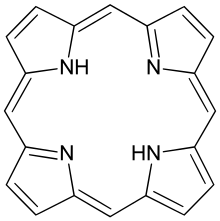
Back بورفين Arabic پورفین AZB Porfin Czech Porphin German Porfina EU پورفین FA Porfiini Finnish Porphine French Porfina GL Porfin Hungarian

| |

| |
| Names | |
|---|---|
| Other names
Porphin
| |
| Identifiers | |
3D model (JSmol)
|
|
| ChEBI | |
| ChemSpider | |
| ECHA InfoCard | 100.002.690 |
PubChem CID
|
|
| UNII | |
CompTox Dashboard (EPA)
|
|
| |
| |
| Properties | |
| C20H14N4 | |
| Molar mass | 310.35196 g/mol |
| Appearance | Dark red, shiny leaflets |
| Melting point | N/A |
Except where otherwise noted, data are given for materials in their standard state (at 25 °C [77 °F], 100 kPa).
| |
Porphine or porphin is an organic compound of empirical formula C20H14N4. It is heterocyclic and aromatic. The molecule is a flat macrocycle, consisting of four pyrrole-like rings joined by four methine bridges, which makes it the simplest of the tetrapyrroles.[1]
The nonpolar tetrapyrrolic ring structure of porphine means it is poorly soluble in most organic solvents and hardly water soluble.[2] As a result, porphine is mostly of theoretical interest. It has been detected in GC-MS of certain fractions of Piper betle.[3]
- ^ "Porphyrin". Encyclopedia of Inorganic and Bioinorganic Chemistry. Wiley-VCH. 2011. doi:10.1002/9781119951438.eibd0638. ISBN 9781119951438.
- ^ Senge, Mathias O.; Davis, Mia (2010). "Porphyrin (porphine) — A neglected parent compound with potential" (PDF). Journal of Porphyrins and Phthalocyanines. 14 (07): 557–567. doi:10.1142/s1088424610002495. ISSN 1088-4246.
- ^ Karak S, Das S, Biswas M, Choudhury A, Dutta M, Chaudhury K, De B (December 2019). "Phytochemical composition, β-glucuronidase inhibition, and antioxidant properties of two fractions of Piper betle leaf aqueous extract". Journal of Food Biochemistry. 43 (12): e13048. doi:10.1111/jfbc.13048. PMID 31581322. S2CID 203661105.